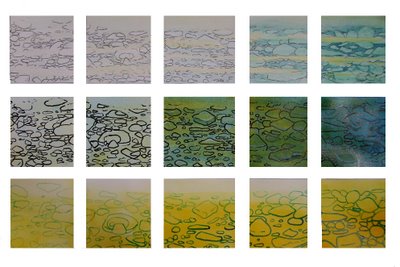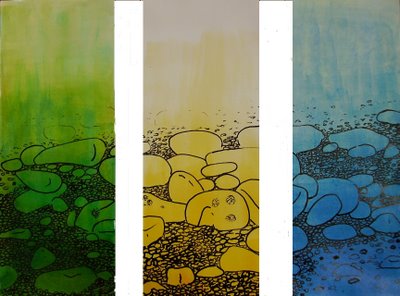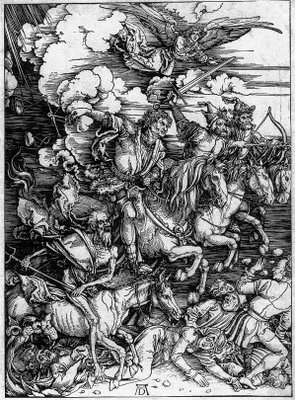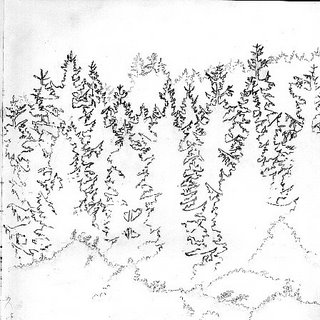Probably not one of my best drawings but while here in Cyprus i have indulged a little bit of artistic anarchy. This image was drawn while exploring the Aphrodite myth, not surprising I suppose. A common technique among modern Cypriot artists is to lay down colour as a background then to draw over this. Much of Cypriot art is reminiscent of Marc Chagall.
Cypriot tastes tend towards painting rather than drawing. So it comes as no surprise to find a strong painterly aspect in most of the work.
Sunday, November 19, 2006
Cyprus Goddess
Friday, November 17, 2006
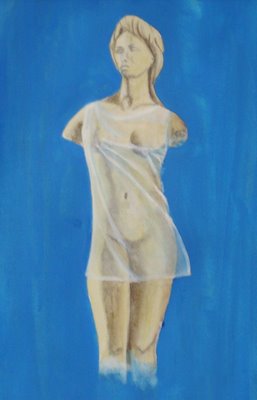 Aphrodite is a small project I have completed here in Cyprus.I have run a feature on my other Blog. Quite frankly the whole thing started as a joke but as these things do, it developed into something more serious. Using the Paphos statue as a starting point I then went on to upstage Botticelli's famous Birth of Aphrodite by portraying her in a wet tee shirt. The above image is a study in gouache exploring this idea.
Aphrodite is a small project I have completed here in Cyprus.I have run a feature on my other Blog. Quite frankly the whole thing started as a joke but as these things do, it developed into something more serious. Using the Paphos statue as a starting point I then went on to upstage Botticelli's famous Birth of Aphrodite by portraying her in a wet tee shirt. The above image is a study in gouache exploring this idea. Drawing of the Paphos Aphrodite in the Cyprus Museum, Nicosia.
Drawing of the Paphos Aphrodite in the Cyprus Museum, Nicosia.
Wednesday, November 08, 2006
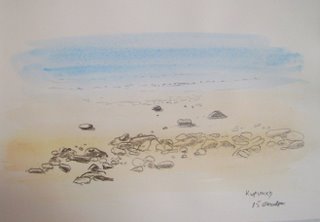
 Two images from the current Cyprus sketchbook. Detailed drawings of the pebbles on the beach. I spend long hours watch/observing the sea before drawing it. The constant shift in tempo requires concentration. Waves tend to follow a repeat pattern. Sailors reckon on every seventh wave repeating. It is about right. But the trick is not so much to draw an individual wave but to capture the ebb and flow.
Two images from the current Cyprus sketchbook. Detailed drawings of the pebbles on the beach. I spend long hours watch/observing the sea before drawing it. The constant shift in tempo requires concentration. Waves tend to follow a repeat pattern. Sailors reckon on every seventh wave repeating. It is about right. But the trick is not so much to draw an individual wave but to capture the ebb and flow.
Wednesday, October 25, 2006
Sunday, October 15, 2006
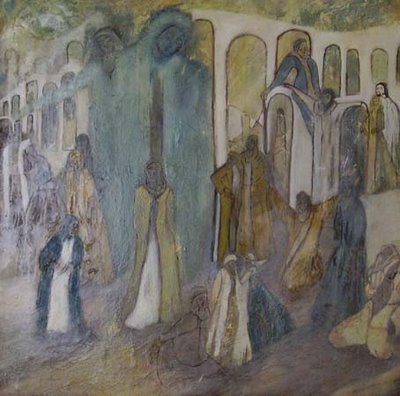 Anna Georghiou is a half English, half Cypriot painter who is doing her MA at the Cyprus College of Art in Limassol. Her work is typically Cypriot yet she has her own individual style. Most of the modern Cyprus art I have seen so far has a very painterly quality to is. But this particular artist uses line to enhance this painterly quality to good effect.
Anna Georghiou is a half English, half Cypriot painter who is doing her MA at the Cyprus College of Art in Limassol. Her work is typically Cypriot yet she has her own individual style. Most of the modern Cyprus art I have seen so far has a very painterly quality to is. But this particular artist uses line to enhance this painterly quality to good effect.She was shortlisted for the Celeste prize last year.
Friday, September 29, 2006
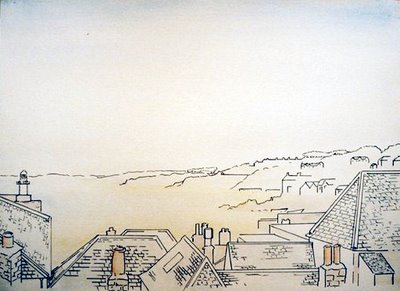
The use of pure line, - albeit with a little colour. Way back in the 1950s when I was serving my time as a draughtsman in structural engineering I came across architect's drawings from time to time and noticed how, unlike us in engineering, they used tone and colour to give their ideas more readable form. Needless to say the Chief Draughtsman took a very dim view of my attempts to emulate this. "Colour and shading is the realm of the artist" I was told. Draughtsmen only deal in facts or proposed facts.
Anyway, the firm went "to the wall" and I finished up in art school.
But the echoes of my involvement with technical drawing/architectural drawing remain. This image was drawn two or three years ago during a stay in St. Ives in Cornwall. Sometimes line is enough. I did this drawing on site and added some watercolour later, rather in the manner of those architects from my youth.
Thursday, September 28, 2006

This figure on my Flickr badge at the moment and may rouse some curiosity. I did it a couple of years ago when I was experimenting with printing techniques. I had made the drawing from a fashion magazine photograph and then made a plate from the drawing. Drawing at a second remove as it were.The image shown here is on a piece of paper already imprinted with the pattern of annular rings that were taken from a transected tree trunk in much the same way as brass rubbings are made. This print, - no bigger than a postcard, - is the result.
The print has sat pasted to a wall in the corner of my studio since then and only recently grabbed my attention as I was taking it down from the wall. We at Luneside are in the process of clearing up. A Compulsory Purchase Order is now in force on the property we occupy so we will have to find a new home. Lancaster appears to be a city being taken over by developers. I suppose that is true for a number of places.
One positive thing I suppose, to this enforced move, is it gives us the chance to look at some archive material, some of which can be surprisingly good but some is best left forgotten. Other artists who read this blog will know exactly what I mean.
Saturday, September 23, 2006
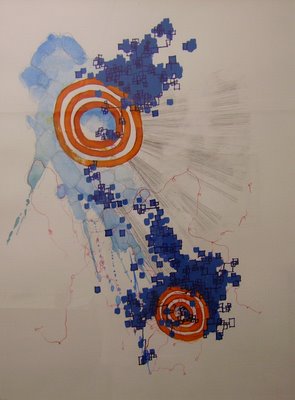
Emma Hunter is an artist at Luneside Studios in Lancaster who does abstracts with draughtsmanly qualities which I find rather exciting. An example is posted here.She makes abstract images on the paper in a very painterly way and follows this up by drawing meticulous geometric patterns. A wonderful juxtaposition.
Sunday, September 17, 2006
 During last year's sojourn in Cyprus we had a series of life-drawing sessions on the Saturday afternoons. For three of theses sessions we had the model in the same pose: taken from Euan Uglow's "Point Five Nude". I have an image in the Abbott Hall catalogue but am unable to reproduce it here because its too big to fit in the scanner.
During last year's sojourn in Cyprus we had a series of life-drawing sessions on the Saturday afternoons. For three of theses sessions we had the model in the same pose: taken from Euan Uglow's "Point Five Nude". I have an image in the Abbott Hall catalogue but am unable to reproduce it here because its too big to fit in the scanner.However, this image is a three layer work. First it was painted as a watercolour on a piece of paper 60 cms long. The following two weeks of two hours each had me doing a finished drawing over the painted image.
Close examination will reveal that the original painting is on a different scale to the overlying drawing. This was deliberate as I wanted a certain random factor in the work. The drawing itself was executed in the same way as Euan Uglow did; precise measurement and point marking. Key reference points remained obvious. As is usual for me, the drawing was done using soft graphite.
Saturday, September 16, 2006
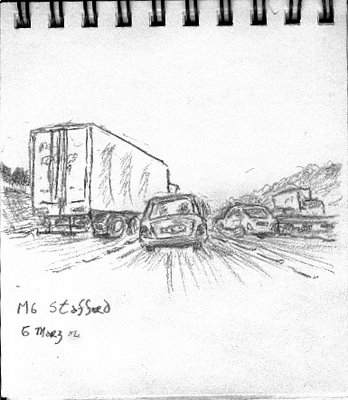 High speed drawing, - at 70 mph. I wasn't driving I hasten to add, but sat in the front passenger seat. It made for an interesting exercise.
High speed drawing, - at 70 mph. I wasn't driving I hasten to add, but sat in the front passenger seat. It made for an interesting exercise.In life-drawing classes, sometimes the students are asked to draw very quickly with the model changing poses every 30 seconds or so. It heightens observational powers.You have to quickly decide which is the important information you need to put on the paper. I call it "outrunning a camera" which you could do in the days of mechanical, non-automatic SLRs but now with digital you just point and shoot. It can make you lazy.
But drawing just for its own sake is stil fun I guess.
Well I enjoy doing it!
Thursday, September 14, 2006
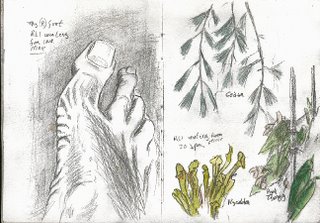 Same sketchbook (2004) but the following day. This time as an outpatient at the local hospital. I was having a few hormone problems at the time and had to go in for a blood test. Lots of waiting. So I drew my right foot. The plant samples are from a garden seen through the waiting room window.
Same sketchbook (2004) but the following day. This time as an outpatient at the local hospital. I was having a few hormone problems at the time and had to go in for a blood test. Lots of waiting. So I drew my right foot. The plant samples are from a garden seen through the waiting room window.Well the drawing was a better diversion than reading the two year old women's magazines that litter NHS waiting rooms.
Tuesday, September 12, 2006
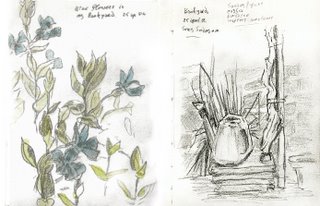 From earlier sketchbooks.......
From earlier sketchbooks.......This one from a small pocket book of 2004. Spread over the two pages, each page A6 size (10.5 x 15 cms). I often keep such a book by me to draw whatever is there. Sometimes it is fleeting imges seen as a passenger in a car or bus, sometimes as shown here, my own backyard, - literally.
None of these are meant to be finished drawings. They are examples of me keeping up the practice. Drawing in this manner needs to be constantly practised otherwise the quality suffers. It is not so much the technical ability to make marks on the paper as the ability to observe things and to record these observations.
The notes on these pieces read, on the left hand page, "Blue flowers in my back yard, 25 apr 04" and on the right hand page, "Backyard 25 April04 - sunny Sunday am." Next to that is a collection of words set out in the style of a haiku.
"Sunday papers
Coffee
Sunshine
Happens sometimes."
Says it all really I s'pose.
Thursday, September 07, 2006
Tuesday, September 05, 2006
 Albrecht Dürer was a German artist and a shining star of the Northern Renaissance. His draughtsmanship was absolutely superb. Records show that he spent huge amounts of time drawing. After that he did more drawing and in his spare time did a bit of ....... drawing. The above gives a good insight into what he did; a self portrait, a drawing of one of his hands, a piece of cloth. There were others contemporanious to this period; Martin Schongauer,Albrecht Altorfer to name but two. This was a golden age of draughtsmanship which alas is in my view, underrated. Museums and galleries seem only to want to show paintings and you really have to burrow to find the drawings. Why is this?
Albrecht Dürer was a German artist and a shining star of the Northern Renaissance. His draughtsmanship was absolutely superb. Records show that he spent huge amounts of time drawing. After that he did more drawing and in his spare time did a bit of ....... drawing. The above gives a good insight into what he did; a self portrait, a drawing of one of his hands, a piece of cloth. There were others contemporanious to this period; Martin Schongauer,Albrecht Altorfer to name but two. This was a golden age of draughtsmanship which alas is in my view, underrated. Museums and galleries seem only to want to show paintings and you really have to burrow to find the drawings. Why is this? This piece, "The Piece of Turf" by Dürer is a finished work in its own right. The detailing is exquisite. Some two years ago the British Museum mountied and exhibition of Dürer's graphic work and I was able tosee some of this work for myself. The photos of it don't do justice to the work.
This piece, "The Piece of Turf" by Dürer is a finished work in its own right. The detailing is exquisite. Some two years ago the British Museum mountied and exhibition of Dürer's graphic work and I was able tosee some of this work for myself. The photos of it don't do justice to the work.
Monday, September 04, 2006
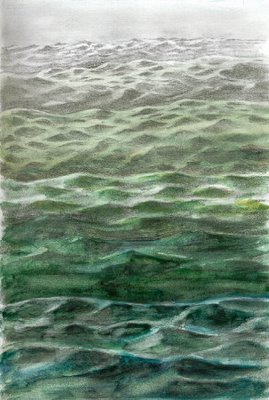 The boundaries between painting and drawing can get a bit blurred at times. I want to show this image from my current sketckbook of the rolling Atlantic. I drew it conventionally enough with a 4B and 2B pencil but then added a watercolour wash but used seawater instead. What we have here, with the original at any rate, is a picture of the Atlantic ocean but incorporating the waters of the Atlantic too.
The boundaries between painting and drawing can get a bit blurred at times. I want to show this image from my current sketckbook of the rolling Atlantic. I drew it conventionally enough with a 4B and 2B pencil but then added a watercolour wash but used seawater instead. What we have here, with the original at any rate, is a picture of the Atlantic ocean but incorporating the waters of the Atlantic too.Unlike when I have used water and added salt as seen on my Sept. 2 posting, sea water when it dries clumps the pigment but in a more even way.
Not so sure what the long term implications are here. Will the sea water eventually degrade the paper or for that matter, my brushes? We'll just have to wait and see.
Sunday, September 03, 2006
 Two studies of the waves. This first one done exclusively in dry media: 3B pencil in fact. I did about four of these letterbox shaped drawings on a single piece of A4. Again it is a view from the clifftop of the sea long before it turns into churning foam and breakers on the shore.
Two studies of the waves. This first one done exclusively in dry media: 3B pencil in fact. I did about four of these letterbox shaped drawings on a single piece of A4. Again it is a view from the clifftop of the sea long before it turns into churning foam and breakers on the shore. This next one is a look at how it turns out using varied media. Reading from the left it is in soft graphite, 3B pencil, then a thin watercolour wash and finally 50-50 application of wash and drawing.
This next one is a look at how it turns out using varied media. Reading from the left it is in soft graphite, 3B pencil, then a thin watercolour wash and finally 50-50 application of wash and drawing.
Saturday, September 02, 2006
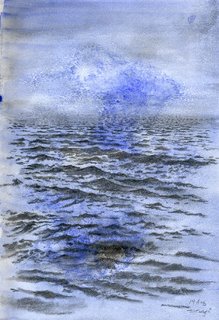
The sea at Tintagel in Cornwall.An almost overhead view seeing I was on top of a 600 foot cliff at the time. It is an intersting viewpoint nonetheless. From this height one can see the general ebb and flow of the sea and the patterns the waves make. Its "seeing the bigger picture" as it were.
Before i went to Tintagel I prepainted some of the pages in my sketchbook; I do and abstract wash then sprinkle salt on it while the page is still wet. The salt mops up some of the pigment and when dry, leaves a random pattern and some rough texture on the paper. I then draw over this later on. The only concsious decision is to draw the sea on a blue page. This image is A4 size.
Wednesday, August 16, 2006
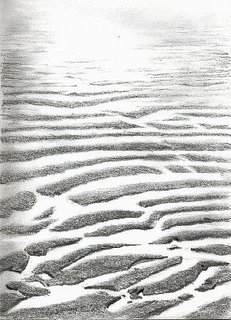
A beach at St. Ives, when the tide is out. I drew this on site last year. I was impressed by the pattern of the sand and the shimmering of the reflected sun.
Thought I would show this one as I will be in Cornwall, Tintagel this time, for a couple of weeks. There will be no more postings until I get back to Lancaster at the end of August.
Drawn in pencil in an A4 drawing book on 150 gsm paper.
Sunday, August 13, 2006

Up to now I have shown "finished" drawings. This example is from one of my sketchbooks. Lets call it "Harvest" for indded that is what it is. Felled trees stacked up waiting to be taken to the sawmills. These tree ends make for an interesting pattern. Subjects like this seem to be popular with photographers if what I see in the photography magazines is anything to go by. I did this one during a stint as volunteer warden at Byrness Youth Hostel in the heart of the Border Forest. There was a bit of a breeze blowing at the time which means the midges left me alone to get on with it. This was drawn using 3B and 4B pencils plus a little bit of blue wash. The tone was softened by rubbing in with a Kleenex.
Overhead there was what I took to be a buzzard wheeling majestically round. When I looked more closely I could see it had white bars on its wings and tail. "White tailed eagle?" Surely not. You only see those in wild and remote places. Then I reminded myself that is exactly where I was. Later, back at the Hostel I checked in my bird book. Yup! It was a white tailed eagle.
That is one thing about drawing out in the field as it were, being still and quiet as I draw, wildlife often does come remarkably close.
Friday, August 11, 2006
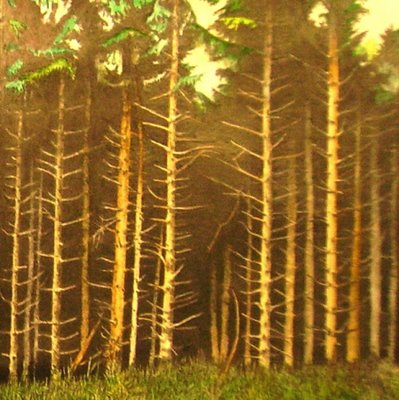 Spithope Three, the right hand panel of the triptych. Now purists may well argue this is a painting, not a drawing and in one sense they would be right. However if you ever get to see the original in my studio in Lancaster it would quickly become apparent this really is a drawing. I think I mentioned in the posting showing the triptych in its entirety that I laid down some water colour first then drew on top of it. The application of water colour approximated where things are but the subsequent layering up using drawing media set the thing a bit more accurately. What in fact I did do was draw in exactly the same way as the centre panel but onto a pretinted paper.
Spithope Three, the right hand panel of the triptych. Now purists may well argue this is a painting, not a drawing and in one sense they would be right. However if you ever get to see the original in my studio in Lancaster it would quickly become apparent this really is a drawing. I think I mentioned in the posting showing the triptych in its entirety that I laid down some water colour first then drew on top of it. The application of water colour approximated where things are but the subsequent layering up using drawing media set the thing a bit more accurately. What in fact I did do was draw in exactly the same way as the centre panel but onto a pretinted paper.So the entire work shows a progression reading from left to right from a pure line drawing through to an elaborate fully developed image. We could use a musical analogy here; imagine a theme played initially on a solo piano, then by a string quartet and finally by a small orchestra. (I shall leave full blown symphony orchestras for large paintings!) .
Thursday, August 10, 2006
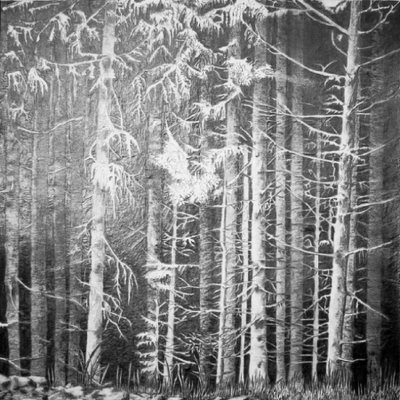
Spithope Two. This is the centre image of the triptych. The middle of the picture is a bit bleached out due to the light reflected of the glossy graphite surface. The intensely dark areas are created using very soft graphite (12B) worked if not ground into the very fabric of the paper which has already had similar treatment with charcoal.
You really get you hands dirty doing this but it is a highly satisfying technique. The end product is a surface not unlike a photographic print.
Wednesday, August 09, 2006
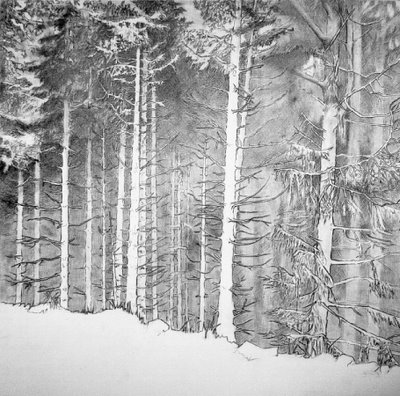
Spithope One. Let's call it that. The left hand component of the Triptych. Spithope (pron: spit-hope) is a remote small valley running fron the Anglo-Scottish border southwards into Redesdale. It is a rather remote spot.
Here we can see where only line has been used. Some might argue that line only is the purest form of drawing. Here the foreground trees and the ground itself is shown in contour. Tone only occours as a backdrop. At full size this image is 42 cms square as are the other two which I shall post later.
This finished work was made in the studio but I did spend a couple of hours doing the preliminary sketches getting a sore bum from sitting on a rock and being eaten alive by midges. Who says I don't suffer for my art?
And yes I did take a few photos as well.
Tuesday, August 08, 2006
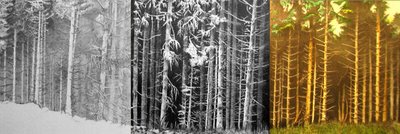
This triptych shows a continuous stretch of forest but divided into three distinct sections each demonstrating a different approach. The left hand image is drawn in pure line. What tone there is, is done as hatching, exclusively in pencil. The centre image is more developed in that tonal values are expressed in graphite and with some charcoal underlay, - almost a "painting" using drawing materials. The image on the right of the triptych, being in colour is rather more painterly but drwing elements remain. The colour was laid down as watercolour but not placed too accurately. Then, once the paper had dried,it was overdrawn using the techniques outlines before. The object of the colur is to provide tinting in much the same way as early black and white photographs were tinted. Not a true dense colour but simply an indication. This work is intended to bring attention to the drawing.
I shall post the three separate images over the next few days so that it can be examined in more detail.
Sunday, August 06, 2006
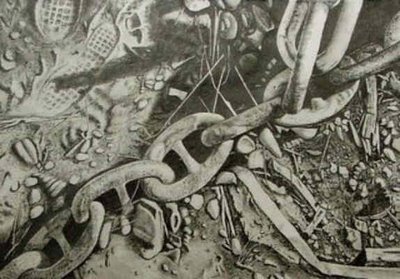 During a residency last year in Cyprus I made this A1 (120 x 84cm) graphite drawing on 300gsm cartridge of an anchor chain embedded in the sand near a boatyard in Limassol. The whole thing showed theobjects as life size.
During a residency last year in Cyprus I made this A1 (120 x 84cm) graphite drawing on 300gsm cartridge of an anchor chain embedded in the sand near a boatyard in Limassol. The whole thing showed theobjects as life size.I had omitted to bring some slides of my work with me to show to the students there so instead made this large drawing as an ongoing demonstration of what I do. It served to illustrate both perception and technique.
This sheer size of this work made it too unwieldly to draw on site. This work was made from a photograph and some smaller sketches.
Saturday, August 05, 2006
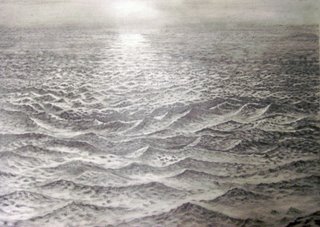 Back in November 2004 I went on a Mediteranean cruise and had the good fortune to have a cabin almost at sea level. We would set sail from whichever harbour we had visited that day and I would sit in my cabin watching the sea go by in the fading light. Eventually the light would become monochrome. This gave excellent opportunities for black and white drawing. I would fill page after page of my sketchbook until the light failed completely. This image is of a large (A2) drawing I did in the studio from these sketches.As this was a sailing ship, the Windsurf, there was no disturbance of the waves, therefore no bow wave and very little wake. Just the endless rolling sea. There's something eternal about the sea; so vast. Two thirds of the planet's surface is covered by it. Thats a whole lot of sea.
Back in November 2004 I went on a Mediteranean cruise and had the good fortune to have a cabin almost at sea level. We would set sail from whichever harbour we had visited that day and I would sit in my cabin watching the sea go by in the fading light. Eventually the light would become monochrome. This gave excellent opportunities for black and white drawing. I would fill page after page of my sketchbook until the light failed completely. This image is of a large (A2) drawing I did in the studio from these sketches.As this was a sailing ship, the Windsurf, there was no disturbance of the waves, therefore no bow wave and very little wake. Just the endless rolling sea. There's something eternal about the sea; so vast. Two thirds of the planet's surface is covered by it. Thats a whole lot of sea.
Friday, August 04, 2006
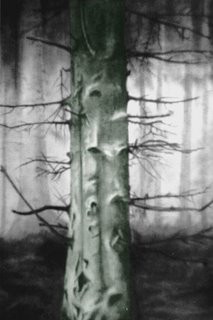
Black and White photography is an important influece in my work. I see black and white photographs in the same context as drawings in the same way colour photography can be analogous to paintings.
Paintings tend to be looked at as the "finished" article by some sectors of the public but I maintain that drawings, - finished drawings as opposed to sketches, - stand as finished works of art in their own right.
This example here, though not entirely monochrome, - there is some tinting of the tree trunk, - is called, not surprisingly, "Greenstem".
It is a study of the lower stem of a coniferous tree and presented in the way it would confront you were you to encounter it in the forest. In the drawing I have mainly used soft graphite (9B or 12B) and 6B for the finer lines. It is drawn on Fabriano textured paper 400gsm. I like this heavy paper for its texture and its ability to withstand being assaulted by me grinding in the graphite untill it becomes an integral part of the paper. Putty rubbers water spraying are other agencies brought into play for a work like this. The work measures 45 x 65 cm.
Thursday, August 03, 2006
Wednesday, August 02, 2006

A figure study to start with. From time to time we at Luneside Studios run life drawing sessions. These are open to friends of the studio, a limited number of artists known to us and some bona fide students as well as ourselves.
This particular study was done in 2004. I deliberately limited my media to a micro pencil with a 0.5mm lead. These pencils are an echo from my engineering drawing days of a lifetime ago. It is a good exercise to sometimes restrict the medium and thereby explore its (sometimes hidden) possibilities.
This drawing is about 42 cm square. It was drawn on a sheet of A2 paper cut down to a square format. For some reason I seem to prefer this [square] format just now.
Subscribe to:
Posts (Atom)
